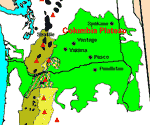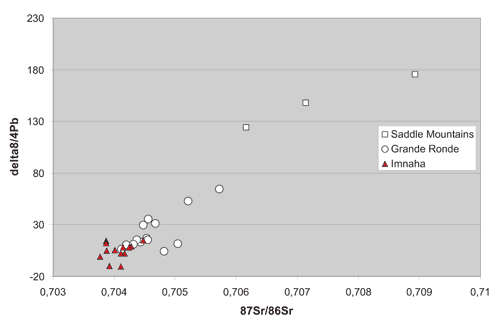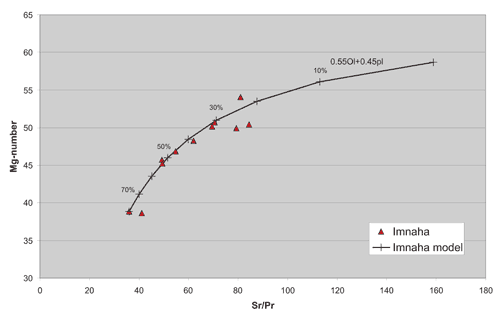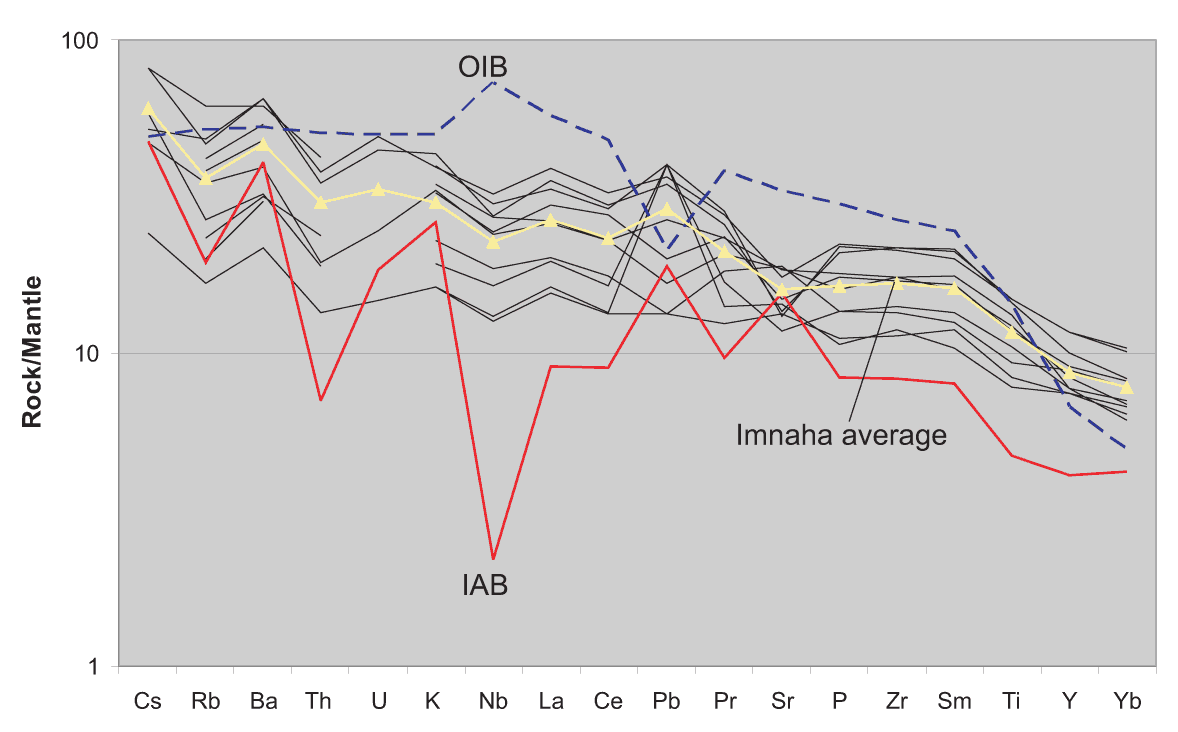 |
The
Columbia River Flood Basalts:
Consequence of subduction-related processes |
Alexei
V. Ivanov
Institute of the Earth’s
Crust, Siberian Branch, Russian Academy of Sciences,
Irkutsk, Russia
aivanov@crust.irk.ru
 Click here to
download a PDF version of this webpage Click here to
download a PDF version of this webpage
Introduction
Many, if not all, continental
flood basalts are characterized by subduction-like trace-element
fingerprints. Conventionally, this is interpreted as
evidence for a lithospheric contribution to magmatism
(e.g., Hooper & Hawkesworth, 1993, Hooper
et al.,
2007). Recently, a lithospheric source for such
magmas was ruled out using Ethiopian and Siberian flood
basalts as example (Kieffer et al., 2004; Ivanov,
2007). The question then remains, regarding what
process may result in sublithospheric subduction-like
trace-element signatures in regions remote from subduction?
Kieffer et al. (2004) advocate a plume source
for such magmas. Ivanov
(2007) suggests water recycling through the mantle
transition zone. This question was recently highlighted
as a part of an open,
web-hosted discussion of the paper by Hooper
et al.
(2007), which concerns the Columbia River flood
basalts. According to Hooper
et al.
(2007), these basalts are the consequence of a lower-mantle
plume. The Columbia River flood basalts bear prominent
subduction-like trace-element signatures, and this was
interpreted as a result of contamination of an OIB-like
plume component by the lower crust. The Columbia River
flood basalts are an excellent example with which to
test whether subduction-like trace-element signatures
are the result of contamination of plume material or
simply the result of subduction itself.
Contamination
In Figure 1, I plot Δ8/4Pb
versus 87Sr/86Sr for three formations,
the Imnaha, Grande Ronde and Saddle Mountains. The Saddle
Mountains formation is considered to be contaminated
by mafic lower crust (Chesly & Ruiz, 1998).
This may be in situ contamination, or recycling
of a mafic component (e.g., delaminated continental
and/or oceanic crust; Escrig et al., 2004;
Ivanov & Balyshev, 2005; Ivanov,
2007). Regardless, the linear trend in Figure 1
shows the involvement of two end-members, a "mantle"
and a "crustal" one. The Imnaha basalts belong
to the mantle end-member. They are not contaminated.

Figure 1. Δ8/4Pb
versus 87Sr/86Sr in three formations
of the Columbia River flood basalt province. Original
data are after (Hooper & Hawkesworth, 1993). Δ8/4Pb
is 100 x [(208Pb/204Pb)/(1.209
(206Pb/204Pb)+15.627)] (Hart,
1984). Saddle Mountains shows typical DUPAL values (Hart,
1984).
Differentiation
of the Imnaha basalts
The Imnaha basalts are
too low in Mg# to be primary mantle-derived melts (Figure
2). The trend in Mg# versus Sr/Pr shows that olivine
and plagioclase fractionation controls their composition.
The curve through the data represents an equilibrium
back-addition of these two minerals to restore the primary
melt composition. The proportion of olivine and plagioclase
was kept constant through the model (olivine/plagioclase
= 0.55/0.45). The primary melt had a Mg# close to 60
and Sr/Pr close to 160 (Figure 2).

Figure 2. Mg# [Mg/(Mg+0.85Fe)]
vs Sr/Pr in Imnaha basalts. Original data are after
Hooper & Hawkesworth (1993). Curve represents equilibrium
crystallization of olivine and plagioclase (Shaw, 1970).
Degree of fractionation increases with decreasing Mg#
and Sr/Pr values. DMgO/FeO and DSr/Pr are
taken as 2.8 and 31 respectively for olivine and plagioclase.
Trace elements in the
primary Imnaha melt
Figure 3 gives an overview
of trace element patterns in uncontaminated Imnaha basalts
(a few contaminated samples shifted towards higher Δ8/4Pb
and 87Sr/86Sr are excluded
in Figure 3). These Imnaha basalts are significantly
different from the modeled uncontaminated ocean island
basalt (OIB) of Sun & McDonough (1989).
Instead, they show similarities with island arc basalts
(IAB in Figure 3 is an average of high-Mg basalts of
Klyuchevskoi volcanics, Kamchatka (Dorendorf et
al., 2000)). These similarities become more obvious
if real basalt compositions are recalculated to their
primary melt composition (Figure 4). All peaks and troughs
of typical IAB, with no exceptions, are mirrored by
the primitive Imnaha melt (Figure 4). The only difference
is the magnitude of the Th and Nb troughs. The difference
with the OIB is striking (Figure 4).

Figure 3. Primitive,
mantle-normalized trace-element patterns of uncontaminated
Imnaha basalts compared with OIB and IAB. Original data
for Imnaha basalts are after Hooper & Hawkesworth
(1993). OIB and IAB are after Sun & McDonough (1989)
and Dorendorf et al. (2000).

Figure 4. Primitive
mantle-normalized trace-element patterns for average
of Imnaha basalt and its modeled primary melt compared
with IAB. Distribution coefficients for modeling are
listed in Table 1.
Table 1. Mineral/melt
distribution coefficients for selected elements used
for derivation of trace-element patterns of evolved
IAB melt (see Figure 1). Values for plagioclase and
olivine are based on Dunn & Sen (1994). Values for
clinopyroxene are after a compilation of Zack et al.
(1997). Asterisks mark extrapolated values.
| |
Plagioclase |
Clinopyroxene |
Olivine |
| Cs |
0.034 |
0.001 |
0.0001* |
| Rb |
0.023 |
0.0047 |
0.0085 |
| Ba |
0.69 |
0.0007 |
0.001* |
| Th |
0.064 |
0.012 |
0.01* |
| U |
0.078 |
0.01 |
0.01* |
| K |
0.5* |
0.05* |
0.003* |
| Nb |
0.024 |
0.0077 |
0.0035 |
| La |
0.12 |
0.054 |
0.00001* |
| Ce |
0.097 |
0.086 |
0.024 |
| Pb |
0.44 |
0.1* |
0.0055 |
| Pr |
0.077 |
0.14 |
0.031 |
| Sr |
2.38 |
0.13 |
0.012 |
| P |
0.1* |
0.125* |
0.013 |
| Zr |
0.00018 |
0.12 |
0.015* |
| Sm |
0.048 |
0.29 |
0.016 |
| Ti |
0.037 |
0.38 |
0.015* |
| Y |
0.012 |
0.47 |
0.029 |
| Yb |
0.0098 |
0.43 |
0.053 |
Discussion
and conclusions
Primitive mantle-derived
melt from the Columbia River flood basalt province is
similar to typical IAB and remarkably different from
OIB. Thus, its origin should be similar to the origin
of IAB, which is the partial melting of a subduction
mantle wedge (e.g., Ulmer, 2001). The mantle
wedge is a part of the depleted upper mantle enriched
by water-soluble elements (e.g., Cs, Ba, K,
Sr, Pb). High-field-strength elements (e.g.,
Ta, Nb, Zr, Ti) and heavy rare-earth elements are not
transported by water. Other elements (e.g.,
Rb, Th, La, Ce, Pr) are moderately soluble in water
(e.g., Ulmer, 2001). These make the IAB trace-element
patterns recognizable throughout geological history.
There is no problem in
explaining Columbia River flood basalts in terms of
subduction-related processes – a subduction zone
is nearby. However, many other flood basalt provinces
show similar subduction-like trace-element geochemistry
and some of them were far from active subduction zones
when they erupted. A new model for the formation of
flood basalt provinces would involve five steps (Ivanov,
2007);
-
transport of water
deep into the upper mantle, perhaps even into the
transition zone, via slab subduction,
-
release of water
from the slab as a result of heating of the slab
to ambient mantle temperature,
-
rising of buoyant,
water-saturated peridotitic diapirs,
-
partial melting
of rising diapirs on crossing the wet solidus, and
accumulation of melt beneath the lithosphere,
-
a drainage
event.
Step 3 may be termed the
"plume event", because the water-saturated
diapirs would rise by virtue of their own buoyancy.
The addition of water into olivine significantly increases
its volume. For example, the addition of 0.5 wt.
% of H2O into forsterite causes volumetric
expansion equal to that which would result from heating
by 240¾C at zero pressure (Smyth et al.,
2006). Such plumes, however, have nothing to do with
the classical plume concept involving thermal boundary
layers (Campbell,
2005).
References
-
-
Chesley, J.T.
and Ruiz, J., 1998. Crust-mantle interaction in
large igneous provinces: Implications from Re-Os
isotope systematics of the Columbia River flood
basalts. Earth. Planet. Sci. Lett., 154,
1-11.
-
Dorendorf,
F., Wiechert, U. and Wörner, G., 2000. Hydrated
sub-arc mantle: a source for the Klyuchevskoy volcano,
Kamchatka/Russia. Earth Planet. Sci. Lett.,
175, 69-86.
-
Dunn, T. and
Sen, C., 1994. Mineral/matrix partition coefficients
for orthopyroxene, plagioclase, and olivine in basaltic
to andesitic systems: A combined analytical and
experimental study: Geochimica et Cosmochimica
Acta, 58, 717-733.
-
Escrig, S.,
Capmas, F., Dupré, B. and Allègre,
C.J., 2004. Osmium isotopic constraints on the nature
of the DUPAL anomaly from Indian mid-ocean-ridge
basalts, Nature, 431,
59-63.
-
Hart, S.R.,
1984. A large-scale isotope anomaly in the Southern
Hemisphere mantle. Nature, 309,
753-757.
-
Hooper, P.R.
and Hawkesworth, C.J., 1993. Isotopic and geochemical
constraints on the origin and evolution of the Columbia
River basalts: Journal of Petrology, 34,
1203-1246.
-
Hooper,
P.R., Camp, V., Reidel, S., and Ross M., 2007. The
origin of the Columbia River flood basalt province:
Plume versus nonplume models. In: Foulger, G.R.,
Jurdy, D.M. (Eds.). Plates, Plumes and Planetary
Processes. Princeton: Geological Society of
America Special Paper 540, in press.
-
-
Ivanov
A.V., Balyshev S.V. Mass flux across the lower-upper
mantle boundary: vigorous, absent, or limited?,
in: Foulger G.R., Natland J.H., Presnall D.C., Anderson
D.L., eds., Plates, Plumes and Paradigms:
Geological Society of America Special Paper 388,
2005, p. 327-346.
-
Kieffer, B.,
Arndt, N., Lapierre, H., Bastien, F., Bosch, D.,
Pecher, A., Yirgu, G., Ayalew, D., Weis, D., Jerram,
D.A., Keller, F., and Meugniot, C., 2004, Flood
and shield basalts from Ethiopia: Magmas from the
African superswell: Journal of Petrology,
45, 793-834.
-
Shaw, D.M.,
1970. Trace element fractionation during anatexis.
Geochim. Cosmochim. Acta., 34,
237-243.
-
Smyth, J.R.,
Frost, D.J., Nestola, F., Holl, C.M., Bromiley,
G., 2006. Olivine hydration in the deep upper mantle:
Effect of temperature and silica activity. Geophys.
Res. Lett., 33, L15301.
-
Sun, S.-S.,
McDonough, W.F., 1989. Chemical and isotopic systematics
of oceanic basalts: Implications for mantle composition
and process. In: Saunders, A.D., Norry M.J. (Eds.).
Magmatism in the oceanic basins. Geol.
Soc. Spec. Publ. No. 42, 313-345.
-
Ulmer, P.,
2001. Partial melting in the mantle wedge –
the role of H2O in the genesis of mantle-derived
‘arc-related’ magmas. Phys. Earth.
Planet. Interiors, 127, 215-232.
-
Zack, T.,
Foley, S.F. and Jenner, G.A., 1997, A consistent
partition coefficient set for clinopyroxene, amphibole
and garnet from laser ablation microprobe analysis
of garnet pyroxenites from Kakanui, New Zealand:
Neues Jahrbuch fur Mineralohie-Abhandlungen,
172, 23-41.
last updated 20th February,
2007 |
